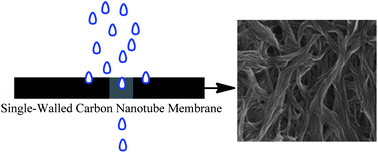Synthesis, properties and water permeability of SWNT buckypapers†
Abstract
The ability of macrocyclic

* Corresponding authors
a
Soft Materials Group, School of Chemistry, University of Wollongong, Wollongong, Australia
E-mail:
sralph@uow.edu.au
b
Membrane Filtration Research Group, School of Civil Mining and Environmental Engineering, University of Wollongong, Australia
E-mail:
longn@uow.edu.au
c
Institute of Materials Engineering, Australian Nuclear Science and Technology Organisation, Lucas Heights, Australia
E-mail:
gerry.triani@ansto.gov.au
d
ARC Centre of Excellence for Electromaterials Science, University of Wollongong, Wollongong, NSW 2522, Australia
E-mail:
panhuis@uow.edu.au
The ability of macrocyclic

 Please wait while we load your content...
Something went wrong. Try again?
Please wait while we load your content...
Something went wrong. Try again?
L. J. Sweetman, L. Nghiem, I. Chironi, G. Triani, M. in het Panhuis and S. F. Ralph, J. Mater. Chem., 2012, 22, 13800 DOI: 10.1039/C2JM31382K
To request permission to reproduce material from this article, please go to the Copyright Clearance Center request page.
If you are an author contributing to an RSC publication, you do not need to request permission provided correct acknowledgement is given.
If you are the author of this article, you do not need to request permission to reproduce figures and diagrams provided correct acknowledgement is given. If you want to reproduce the whole article in a third-party publication (excluding your thesis/dissertation for which permission is not required) please go to the Copyright Clearance Center request page.
Read more about how to correctly acknowledge RSC content.
 Fetching data from CrossRef.
Fetching data from CrossRef.
This may take some time to load.
Loading related content
